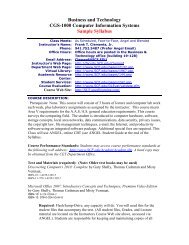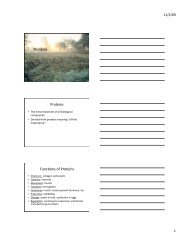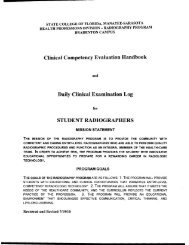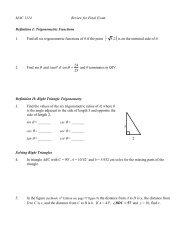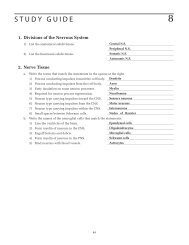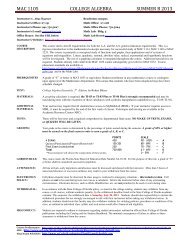Free Energy and Thermodynamics - Scf
Free Energy and Thermodynamics - Scf
Free Energy and Thermodynamics - Scf
You also want an ePaper? Increase the reach of your titles
YUMPU automatically turns print PDFs into web optimized ePapers that Google loves.
“<strong>Free</strong> <strong>Energy</strong><br />
<strong>and</strong><br />
<strong>Thermodynamics</strong>”<br />
Chapter 17<br />
First Law of <strong>Thermodynamics</strong> <br />
• First Law of <strong>Thermodynamics</strong>: <strong>Energy</strong> cannot <br />
be Created or Destroyed <br />
– the total energy of the universe cannot change <br />
– though you can transfer it from one place to <br />
another <br />
• ΔE universe = 0 = ΔE system + ΔE surroundings <br />
First Law of <strong>Thermodynamics</strong> <br />
• Conserva>on of <strong>Energy</strong> <br />
• For an exothermic reac>on, “lost” heat from the system <br />
goes into the surroundings <br />
• two ways energy “lost” from a system, <br />
– converted to heat, q <br />
– used to do work, w <br />
• <strong>Energy</strong> conserva>on requires that the energy change in <br />
the system equal the heat released + work done <br />
– ΔE = q + w <br />
– ΔE = ΔH + PΔV <br />
• ΔE is a state func,on <br />
– internal energy change independent of how done <br />
7/2/08<br />
1
<strong>Energy</strong> Tax <br />
• You can’t break even! <br />
• To recharge a baLery with 100 <br />
kJ of useful energy will require <br />
more than 100 kJ <br />
• Every energy transi>on results <br />
in a “loss” of energy <br />
– conversion of energy to heat <br />
which is “lost” by hea>ng up <br />
the surroundings <br />
Heat Tax <br />
<strong>Thermodynamics</strong> <strong>and</strong> Spontaneity <br />
• <strong>Thermodynamics</strong> predicts whether a process will <br />
proceed under the given condi>ons <br />
– spontaneous process <br />
• nonspontaneous processes require energy input to go <br />
• Spontaneity is determined by comparing the free <br />
energy of the system before the reac>on with the <br />
free energy of the system aPer reac>on. <br />
• Spontaneity ≠ fast or slow <br />
7/2/08<br />
2
Comparing Poten>al <strong>Energy</strong> <br />
The direc>on <br />
of spontaneity <br />
can be <br />
determined by <br />
comparing the <br />
poten>al <br />
energy of the <br />
system at the <br />
start <strong>and</strong> the <br />
end. <br />
<strong>Thermodynamics</strong> vs. Kine>cs <br />
Factors Affec>ng Whether a Reac>on <br />
Is Spontaneous <br />
• The two factors that determine the <br />
thermodynamic favorability are the enthalpy <strong>and</strong> <br />
the entropy. <br />
• The enthalpy is a comparison of the bond energy <br />
of the reactants to the products. <br />
– bond energy = amount needed to break a <br />
bond. <br />
– ΔH <br />
• The entropy factors relates to the r<strong>and</strong>omness/<br />
orderliness of a system <br />
– ΔS <br />
• The enthalpy factor is generally more important <br />
than the entropy factor <br />
7/2/08<br />
3
Enthalpy <br />
• Related to the internal energy <br />
• ΔH generally kJ/mol <br />
• Stronger bonds = more stable molecules <br />
• If products more stable than reactants, energy released <br />
– exothermic <br />
– ΔH = nega>ve <br />
• If reactants more stable than products, energy absorbed <br />
– endothermic <br />
– ΔH = posi>ve <br />
• The enthalpy is favorable for exothermic reac>ons <strong>and</strong> <br />
unfavorable for endothermic reac>ons. <br />
• Hess’ Law ΔH° rxn = Σ(ΔH° prod) ‐ Σ(ΔH° react) <br />
Entropy <br />
• Entropy is a thermodynamic func>on that increases <br />
as the number of energe>cally equivalent ways of <br />
arranging the components increases, S <br />
• S generally J/mol <br />
• S = k ln W <br />
– k = Boltzmann Constant = 1.38 x 10 ‐23 J/K <br />
– W is the number of energe>cally equivalent ways, unitless <br />
• R<strong>and</strong>om systems require less energy than ordered <br />
systems <br />
• Energe>cally Equivalent <br />
States for the Expansion <br />
of a Gas <br />
W <br />
7/2/08<br />
4
Macrostates Microstates <br />
• These microstates <br />
all have the same <br />
macrostate <br />
• So there are 6 <br />
different par>cle <br />
arrangements <br />
that result in the <br />
same macrostate <br />
Macrostates <strong>and</strong> Probability <br />
• There is only one possible <br />
arrangement that gives State A <br />
<strong>and</strong> one that gives State B <br />
• There are 6 possible <br />
arrangements that give State C <br />
• Therefore State C has higher <br />
entropy than either State A or <br />
State B <br />
• The macrostate with the highest <br />
entropy also has the greatest <br />
dispersal of energy <br />
Changes in Entropy, ΔS <br />
• Entropy change is favorable when the result is a <br />
more r<strong>and</strong>om system. <br />
– ΔS is posi>ve <br />
• Some changes that increase the entropy are: <br />
– reac>ons whose products are in a more <br />
disordered state. <br />
• (solid > liquid > gas) <br />
– reac>ons which have larger numbers of product <br />
molecules than reactant molecules. <br />
– increase in temperature <br />
– solids dissocia>ng into ions upon dissolving <br />
7/2/08<br />
5
Increase in Entropy <br />
The 2 nd Law of <strong>Thermodynamics</strong> <br />
• The total entropy change of the universe must be <br />
posi>ve for a process to be spontaneous <br />
– for reversible process ΔS univ = 0, <br />
– for irreversible (spontaneous) process ΔS univ > 0 <br />
• ΔS universe = ΔS system + Δs surroundings <br />
• If the entropy of the system decreases, then the <br />
entropy of the surroundings must increase by a <br />
larger amount <br />
– when ΔS system is nega>ve, ΔS surroundings is posi>ve <br />
• The increase in ΔS surroundings oPen comes from the <br />
heat released in an exothermic reac>on <br />
Entropy Change in State Change <br />
• When materials change state, the number of <br />
macrostates it can have changes as well <br />
– for entropy: solid
Entropy Change <strong>and</strong> State Change <br />
Heat Flow, Entropy, <strong>and</strong> the 2 nd Law <br />
• Heat must flow from <br />
water to ice in order for <br />
the entropy of the <br />
universe to increase <br />
Temperature Dependence of ΔS surroundings <br />
• When a system process is exothermic, it adds heat to <br />
the surroundings, increasing the entropy of the <br />
surroundings <br />
• When a system process is endothermic, it takes heat <br />
from the surroundings, decreasing the entropy of the <br />
surroundings <br />
• The amount the entropy of the surroundings changes <br />
depends on the temperature it is at originally <br />
7/2/08<br />
7
Gibbs <strong>Free</strong> <strong>Energy</strong>, ΔG <br />
• Maximum amount of energy from the system <br />
available to do work on the surroundings <br />
G = H – T∙S <br />
ΔG sys = ΔH sys – TΔS sys<br />
ΔG sys = – TΔS universe <br />
ΔG reacGon = Σ nΔG prod – Σ nΔG react <br />
• When ΔG on C 3 H 8(g) + 5 O 2(g) → 3 CO 2(g) + 4 <br />
H 2 O (g) has ΔH rxn = ‐2044 kJ at 25°C. <br />
Calculate the entropy change of the <br />
surroundings <br />
<strong>Free</strong> <strong>Energy</strong> Change <strong>and</strong> Spontaneity <br />
7/2/08<br />
8
Gibbs <strong>Free</strong> <strong>Energy</strong>, ΔG <br />
• Process will be spontaneous when ΔG is nega>ve <br />
• ΔG will be nega>ve when <br />
– ΔH is nega>ve <strong>and</strong> ΔS is posi>ve <br />
• exothermic <strong>and</strong> more r<strong>and</strong>om <br />
– ΔH is nega>ve <strong>and</strong> large <strong>and</strong> ΔS is nega>ve but <br />
small <br />
– ΔH is posi>ve but small <strong>and</strong> ΔS is posi>ve <strong>and</strong> <br />
large <br />
• or high temperature <br />
• ΔG will be posi>ve when ΔH is + <strong>and</strong> ΔS is − <br />
– never spontaneous at any temperature <br />
• When ΔG = 0 the reac>on is at equilibrium <br />
ΔG, ΔH, <strong>and</strong> ΔS <br />
Example <br />
• The reac>on CCl 4(g) → C (s, graphite) + 2 Cl 2(g) has <br />
ΔH = +95.7 kJ <strong>and</strong> ΔS = +142.2 J/K at 25°C. <br />
Calculate ΔG <strong>and</strong> determine if it is <br />
spontaneous. <br />
7/2/08<br />
9
The 3 rd Law of <strong>Thermodynamics</strong> <br />
Absolute Entropy <br />
• The absolute entropy of a <br />
substance is the amount of <br />
energy it has due to dispersion of <br />
energy through its par>cles <br />
• The 3 rd Law states that for a <br />
perfect crystal at absolute zero, <br />
the absolute entropy = 0 J/mol∙K <br />
– therefore, every substance that is <br />
not a perfect crystal at absolute zero <br />
has some energy from entropy <br />
– therefore, the absolute entropy of <br />
substances is always + <br />
St<strong>and</strong>ard Entropies <br />
• S° <br />
• Extensive <br />
• Entropies for 1 mole at 298 K for a par>cular <br />
state, a par>cular allotrope, par>cular <br />
molecular complexity, a par>cular molar mass, <br />
<strong>and</strong> a par>cular degree of dissolu>on <br />
Rela>ve St<strong>and</strong>ard Entropies <br />
States <br />
• The gas state has a <br />
larger entropy than the <br />
liquid state at a <br />
par>cular temperature <br />
• The liquid state has a <br />
larger entropy than the <br />
solid state at a <br />
par>cular temperature <br />
Substance<br />
S°,<br />
(J/mol·K)<br />
H 2O (g) 70.0<br />
H 2O (l) 188.8<br />
7/2/08<br />
10
Rela>ve St<strong>and</strong>ard Entropies <br />
Molar Mass <br />
• The larger the molar <br />
mass, the larger the <br />
entropy <br />
• Available energy states <br />
more closely spaced, <br />
allowing more dispersal <br />
of energy through the <br />
states <br />
Rela>ve St<strong>and</strong>ard Entropies <br />
Allotropes <br />
• The less constrained the <br />
structure of an <br />
allotrope is, the larger <br />
its entropy <br />
Rela>ve St<strong>and</strong>ard Entropies <br />
Molecular Complexity <br />
• Larger, more complex <br />
molecules generally <br />
have larger entropy <br />
• More available energy <br />
states, allowing more <br />
dispersal of energy <br />
through the states <br />
7/2/08<br />
11
Rela>ve St<strong>and</strong>ard Entropies <br />
Dissolu>on <br />
• Dissolved solids <br />
generally have larger <br />
entropy <br />
• Distribu>ng par>cles <br />
throughout the mixture <br />
Example <br />
S°,<br />
Substance<br />
(J/mol·K)<br />
KClO3 (s) 143.1<br />
KClO 3 (aq) 265.7<br />
• Calculate ΔS° for the reac>on <br />
4 NH 3(g) + 5 O 2(g) → 4 NO (g) + 6 H 2 O (l) <br />
Calcula>ng ΔG° <br />
• At 25°C: <br />
ΔG o reac>on = ΣnGo f (products) ‐ ΣnGo f (reactants) <br />
• At temperatures other than 25°C: <br />
– assuming the change in ΔH o reac>on <strong>and</strong> ΔSo reac>on is <br />
negligible <br />
ΔG° reacGon = ΔH° reacGon – TΔS° reacGon <br />
7/2/08<br />
12
Example <br />
• Calculate ΔG° at 25°C for the reac>on <br />
CH 4(g) + 8 O 2(g) → CO 2(g) + 2 H 2 O (g) + 4 O 3(g) <br />
ΔG Rela>onships <br />
• If a reac>on can be expressed as a series of <br />
reac>ons, the sum of the ΔG values of the individual <br />
reac>on is the ΔG of the total reac>on <br />
– ΔG is a state func>on <br />
• If a reac>on is reversed, the sign of its ΔG value <br />
reverses <br />
• If the amounts of materials is mul>plied by a factor, <br />
the value of the ΔG is mul>plied by the same factor <br />
– the value of ΔG of a reac>on is extensive <br />
<strong>Free</strong> <strong>Energy</strong> <strong>and</strong> Reversible Reac>ons <br />
• The change in free energy is a theore>cal limit <br />
as to the amount of work that can be done <br />
• If the reac>on achieves its theore>cal limit, it <br />
is a reversible reac>on <br />
7/2/08<br />
13
• In a real reac>on, some <br />
of the free energy is <br />
“lost” as heat <br />
– if not most <br />
• Therefore, real <br />
reac>ons are <br />
irreversible <br />
Real Reac>ons <br />
7/2/08<br />
14





